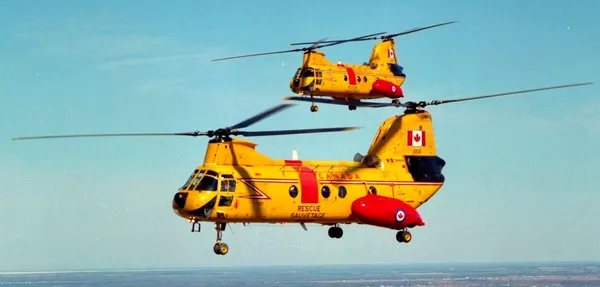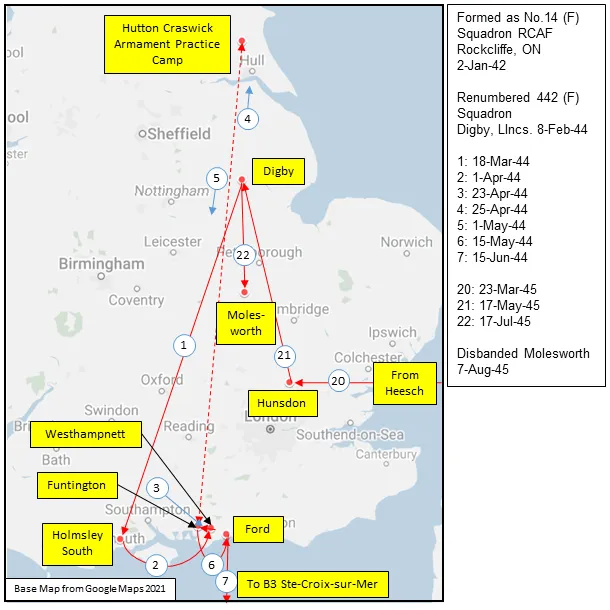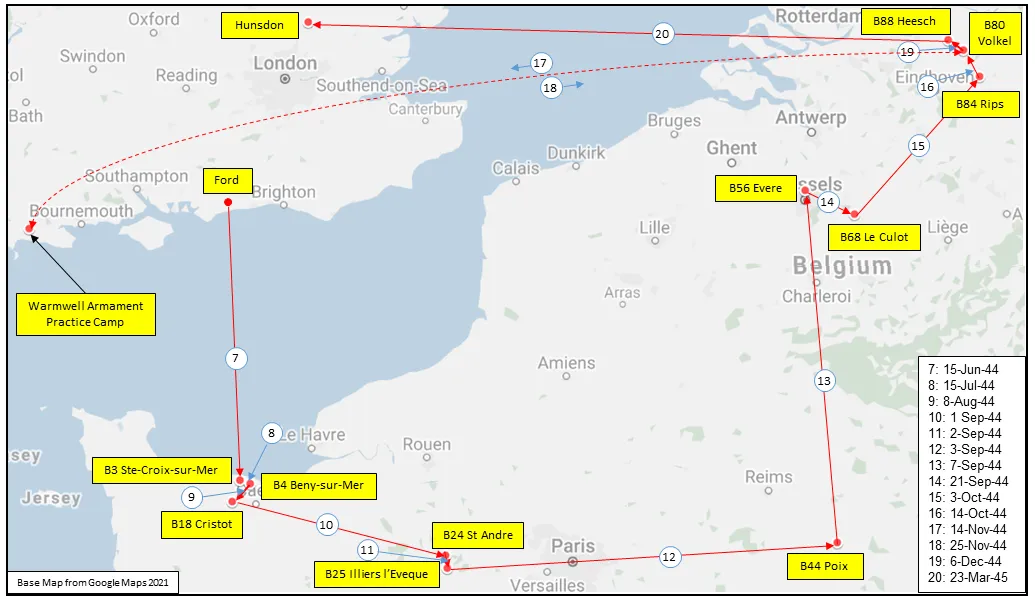Young, Philip Lloyd Cyril (Corporal)
Killed in Flying Accident 1992-April-30


Birth Date: 1963-January-27
Born: Sydney, Nova Scotia
Parents: Son of George Young of Val Caron, Ontario.
Spouse: Husband of Kari-Anne Lind-Young of Comox, British Columbia. Father of Zachary Young.
Home: Sydney, Nova Scotia
Enlistment: Sudbury, Ontario
Enlistment Date: 1984-September-26
Service
RCAF
Unit
442 Sqn- Squadron
Un Dieu, Une Reine, Un Coeur One God, one queen, one heart
Base
Rank
Corporal
Position
Service Numbers
N8406192
Home
Crew or Other Personnel
Labrador/Voyageur 10411
Labrador/Voyageur serial: 10411

Boeing Vertol CH-113 Labrador (Serial No. 11302), in formation.
The Boeing Vertol CH-113 Labrador was the RCAF Search and rescue version of the American Model 107-II-9 (CH-46) Sea Knight helicopter. The CH-113A Voyageur was the Canadian Army Assault and utility transport version of the Model 107-II-28 helicopter, later converted to CH-113A Labrador.
The RCAF procured six CH-113 Labrador helicopters for the SAR role and the Canadian Army acquired 12 of the similar CH-113A Voyageur for the medium-lift transport role. The RCAF Labradors were delivered first with the first one entering service on 11 October 1963. When the larger CH-147 Chinook was procured by the Canadian Forces in the mid-1970s, the Voyageur fleet was converted to Labrador specifications to undertake SAR missions. The refurbished Voyageurs were re-designated as CH-113A Labradors, with a total of 15 Labradors ultimately in service.
The Labrador was fitted with a watertight hull for marine landings, a 5,000 kilogram cargo hook and an external rescue hoist mounted over the right front door. It featured a 1,110 kilometer flying range, emergency medical equipment and an 18-person passenger capacity. By the 1990s, heavy use and hostile weather conditions had taken their toll on the Labrador fleet, resulting in increasing maintenance costs and the need for prompt replacement. In 1981, a mid-life upgrade of the fleet was carried out by Boeing Canada in Arnprior, Ontario. Known as the SAR-CUP (Search and Rescue Capability Upgrade Program), the refit scheme included new instrumentation, a nose-mounted weather radar, a tail-mounted auxiliary power unit, a new high-speed rescue hoist mounted over the side door and front-mounted searchlights. A total of six CH-113s and five CH-113As were upgraded with the last delivered in 1984. The last CH-113 was retired in 2004. Harold A Skaarup Web Page
![]() Wikipedia Boeing Vertol CH-46 Sea Knight
Wikipedia Boeing Vertol CH-46 Sea Knight
![]() YouTube Labrador Helicopter Boeing Vertol SAR Search and Rescue Demo 1995
YouTube Labrador Helicopter Boeing Vertol SAR Search and Rescue Demo 1995
Unit Desciption
442 Sqn Un Dieu, Une Reine, Un Coeur ("Caribou")
History of the Squadron before and during World War II (Aircraft: Spitfire VB, IXB, IXE, Mustang III)

[ Note that during WWII the squadron did not have a badge nor a motto. These were awarded later.]
No 442 (F) Squadron was formed in Rockcliffe, ON ![]() as No. 14 (F) Squadron RCAF on January 2, 1942. It originally flew Curtiss Kittyhawks with the RCAF Western Air Command due to the threat to Canada's west coast after the Pearl Harbor attack. The squadron moved to Alaska and participated on strafing and bombing missions against then-Japanese held Kiska during the Aleutian Islands Campaign. The squadron was the fifth of six home squadrons transferred overseas without its aircraft, and was re-designated No. 442 (F) Squadron RCAF at Digby, Lincolnshire, UK.
as No. 14 (F) Squadron RCAF on January 2, 1942. It originally flew Curtiss Kittyhawks with the RCAF Western Air Command due to the threat to Canada's west coast after the Pearl Harbor attack. The squadron moved to Alaska and participated on strafing and bombing missions against then-Japanese held Kiska during the Aleutian Islands Campaign. The squadron was the fifth of six home squadrons transferred overseas without its aircraft, and was re-designated No. 442 (F) Squadron RCAF at Digby, Lincolnshire, UK.![]() on February 8 1944. It flew Spitfire aircraft in offensive and defensive operations in the preparation for D-Day, and afterwards gave close support to the ground troops. They moved with the ground troops through France, the Low Countries, and Germany. In March 1945 the squadron was re-equipped with Mustang aircraft, to provide fighter cover for long-range bomber groups. The squadron was disbanded at Molesworth, Huntingdonshire, UK
on February 8 1944. It flew Spitfire aircraft in offensive and defensive operations in the preparation for D-Day, and afterwards gave close support to the ground troops. They moved with the ground troops through France, the Low Countries, and Germany. In March 1945 the squadron was re-equipped with Mustang aircraft, to provide fighter cover for long-range bomber groups. The squadron was disbanded at Molesworth, Huntingdonshire, UK ![]() on August 7, 1945.
on August 7, 1945.
In the course of operations, the squadron flew 4954 sorties for the loss of16 pilots, of whom 1 was killed, 9 presumed dead and 4 POWs. They accounted for 56 enemy aircraft confirmed destroyed, 5 probables and 25 damaged. In ground attacks they were credited with 909 motor vehicles, 125 locomotives and 194 trains. The squadron had 1 ace: Flight Lieutenant D.C. Gordon, DFC. The squadron amassed 1 DSO, 3 Bars to DFC, 10 DFCs, 1 Croix de Guerre (France). Battle Honours were: Fortress Europe 1944, France and Germany 1944-45, Normandy 1944, Arnhem, Rhine, Aleutians 1943. Wikipedia, Kostenuk and Griffin
Maps for Movements of 442 Squadron 1944-45

MAP 1: 442 Squadron Movements 1944-45 (right-click on image to display enlarged in new tab)
|

MAP 2: 442 Squadron Movements 1944-45
|
442 Squadron History Summary 1944-45

442 Squadron History Summary 1944-45 Page 2

History of the Squadron Post-WWII (Aircraft: Harvard, Vampire III, Mustang IV, Sabre 5, Expeditor, Otter, Cormorant)

The squadron was re-formed at Vancouver, British Columbia ![]() on 15 April 1946. It was redesignated 442 "City of Vancouver" (F) Squadron on 3 September 1952. It flew de Havilland Vampire, North American Mustang and Canadair Sabre aircraft in a fighter role until October 1958 when it was reassigned to a light transport and emergency rescue role and re-equipped with Beech Expeditor and de Havilland Otter aircraft. It was redesignated 442 Squadron. A reduction of the Auxiliary Force resulted in the squadron being disbanded on 1 April 1964.
on 15 April 1946. It was redesignated 442 "City of Vancouver" (F) Squadron on 3 September 1952. It flew de Havilland Vampire, North American Mustang and Canadair Sabre aircraft in a fighter role until October 1958 when it was reassigned to a light transport and emergency rescue role and re-equipped with Beech Expeditor and de Havilland Otter aircraft. It was redesignated 442 Squadron. A reduction of the Auxiliary Force resulted in the squadron being disbanded on 1 April 1964.
The squadron was re-formed as '442 Communications and Rescue Squadron' on 8 July 1968, from '121 Composite Unit' (authorized 1 January 1959). The squadron is based at Comox, British Columbia ![]() , flying the CH-149 Cormorant Helicopters. The primary role of 442 Transport and Rescue Squadron is the provision of aviation resources in support of the Joint Rescue Coordination Center (JRCC) Victoria. This region consists of approximately 920,000 square kilometers of mainly mountainous terrain of Yukon and British Columbia and 560,000 square kilometers of the Pacific Ocean extending to approximately 600 nautical miles offshore, including over 27,000 kilometers of rugged British Columbia coastline. The rugged and often inaccessible terrain, severe weather, and large expanses of sparsely populated areas make the Victoria SRR the most demanding region in the country.
, flying the CH-149 Cormorant Helicopters. The primary role of 442 Transport and Rescue Squadron is the provision of aviation resources in support of the Joint Rescue Coordination Center (JRCC) Victoria. This region consists of approximately 920,000 square kilometers of mainly mountainous terrain of Yukon and British Columbia and 560,000 square kilometers of the Pacific Ocean extending to approximately 600 nautical miles offshore, including over 27,000 kilometers of rugged British Columbia coastline. The rugged and often inaccessible terrain, severe weather, and large expanses of sparsely populated areas make the Victoria SRR the most demanding region in the country.
While approximately 80 of the Squadron's personnel strength of 200 are aircrew trades, including pilots, navigators, flight engineers, and Search and Rescue Technicians (SAR Techs), the majority are maintenance personnel, charged with keeping the aircraft at peak operational readiness. On occasions when major search operations dictate the establishment of a forward operating base somewhere else in the province, 442's maintenance personnel will deploy with the aircrew, providing servicing and repairs to aircraft on site.